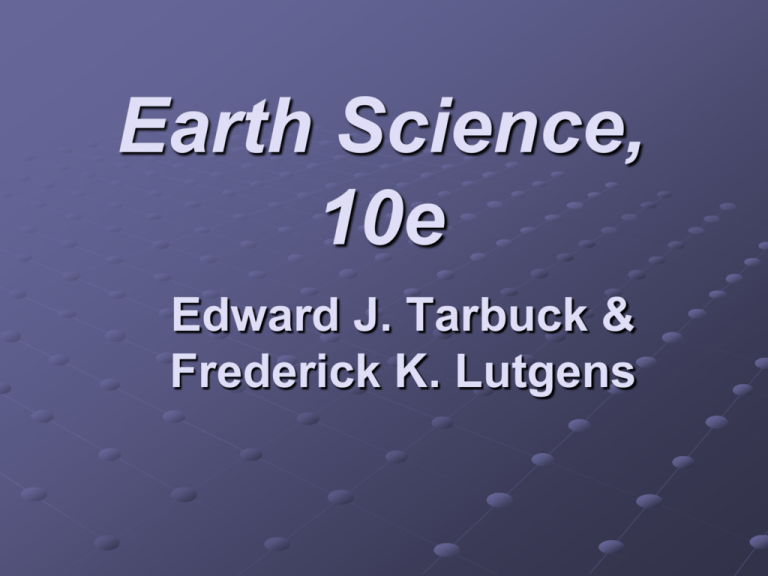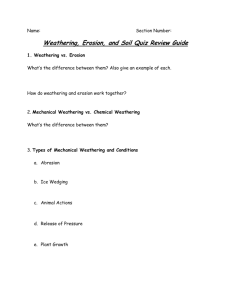Weathering
advertisement

Earth Science, 10e Edward J. Tarbuck & Frederick K. Lutgens Weathering, Soil, and Mass Wasting Chapter 3 Earth's external processes Weathering – the disintegration and decomposition of material at or near the surface Mass wasting – the transfer of rock material downslope under the influence of gravity Erosion – the incorporation and transportation of material by a mobile agent, usually water, wind, or ice Weathering Two kinds of weathering • Mechanical weathering • Breaking of rocks into smaller pieces • Processes of mechanical weathering • Frost wedging • Unloading • Biological activity Frost wedging Unloading and exfoliation of igneous rocks Weathering Two kinds of weathering • Chemical weathering • Alters the internal structures of minerals by removing or adding elements • Most important agent is water • Oxygen dissolved in water oxidizes materials • Carbon dioxide (CO ) dissolved in water forms 2 carbonic acid and alters the material Weathering Two kinds of weathering • Chemical weathering • Weathering of granite • Weathering of potassium feldspar produces clay minerals, soluble salt (potassium bicarbonate), and silica in solution • Quartz remains substantially unaltered • Weathering of silicate minerals produces insoluble iron oxides and clay minerals Rates of weathering Advanced mechanical weathering aids chemical weathering by increasing the surface area Important factors • Rock characteristics • Mineral composition and solubility • Physical features such as joints Increase in surface area by mechanical weathering Rates of weathering Important factors • Climate • Temperature and moisture are the most crucial factors • Chemical weathering is most effective in areas of warm temperatures and abundant moisture Rates of weathering Differential weathering • • Caused by variations in composition Creates unusual and spectacular rock formations and landforms Joint-controlled weathering in igneous rocks Soil An interface in the Earth system Soil is a combination of mineral matter, water, and air – that portion of the regolith (rock and mineral fragments) that supports the growth of plants Typical components in a soil that yields good plant growth Soil Soil texture and structure • Texture refers to the proportions of different particle sizes Sand (large size) Silt Clay (small size) • Loam (a mixture of all three sizes) is best suited for plant life Soil Texture Soil Soil texture and structure • Structure • Soil particles clump together to give a soil its structure • Four basic soil structures • Platy • Prismatic • Blocky • Spheroidal Soil Controls of soil formation • Parent material Residual soil – parent material is the bedrock Transported soil – parent material has been carried from elsewhere and deposited • Time • Important in all geologic processes • Amount of time to evolve varies for different soils Soil Controls of soil formation • • Climate Plants and animals • Organisms influence the soil's physical and chemical properties • Furnish organic matter to soil Soil Controls of soil formation • Slope • Angle • Steep slopes often have poorly developed soils • Optimum is a flat-to-undulating upland surface • Orientation (direction the slope is facing) influences • Soil temperature • Moisture Soil Soil Profile • • • Soil forming processes operate from the surface downward Horizons – zones or layers of soil Horizons in temperate regions • O – organic matter • A – organic and mineral matter • E – little organic matter Soil Soil Profile • Horizons in temperate regions B – zone of accumulation C – partially altered parent material • • O and A together called topsoil O, A, E, and B together called solum, or "true soil" An idealized soil profile A soil profile showing different horizons Soil Soil types • • Hundreds of soil types worldwide Three very generic types • Pedalfer • Accumulation of iron oxides and Al-rich clays in the B-horizon • Best developed under forest vegetation Soil Soil types • Three very generic types • Pedocal • Accumulate calcium carbonate • Associated with drier grasslands • Laterite • Hot, wet, tropical climates • Intense chemical weathering Soil Soil erosion • • Recycling of Earth materials Natural rates of erosion depend on • • • • Soil characteristics Climate Slope Type of vegetation Soil Soil erosion • Soil erosion and sedimentation can cause • Reservoirs to fill with sediment • Contamination by pesticides and fertilizers Weathering creates ore deposits Process called secondary enrichment • • Concentrates metals into economical deposits Takes place in one of two ways • Removing undesired material from the decomposing rock, leaving the desired elements behind • Desired elements are carried to lower zones and deposited Weathering creates ore deposits Examples • • Bauxite, the principal ore of aluminum Many copper and silver deposits Mass Wasting The downslope movement of rock, regolith, and soil under the direct influence of gravity Gravity is the controlling force Important triggering factors • Saturation of the material with water • Destroys particle cohesion • Water adds weight Mass Wasting Important triggering factors • Oversteepening of slopes • Unconsolidated granular particles assume a stable slope called the angle of repose • Stable slope angle is different for various materials • Oversteepened slopes are unstable • • Removal of anchoring vegetation Ground vibrations from earthquakes Mass Wasting Types of mass wasting processes • Generally each type is defined by • The material involved – debris, mud, Earth, or rock • The movement of the material • Fall (free-fall of pieces) • Slide (material moves along a well-defined surface) • Flow (material moves as a viscous fluid) Mass Wasting Types of mass wasting processes • Generally each type is defined by • The rate of the movement • Fast • Slow • Forms of mass wasting • Slump • • Rapid movement along a curved surface Occur along oversteepened slopes A slump with an earthflow at the base Mass Wasting Types of mass wasting processes • Forms of mass wasting • Rockslide • • Rapid Blocks of bedrock move down a slope • Debris flow (mudflow) • • • • Rapid flow of debris with water Often confined to channels Serious problem in dry areas with heavy rains Debris flows composed mostly of volcanic materials are called lahars Forms of mass wasting Mass Wasting Types of mass wasting processes • Forms of mass wasting • Earthflow • • • • Rapid Typically occur on hillsides in humid regions Water saturates the soil Liquefaction - a special type of earthflow sometimes associated with earthquakes An earthflow on a newly formed slope Mass Wasting Types of mass wasting processes • Forms of mass wasting • Creep • • Slow movement of soil and regolith downhill Causes fences and utility poles to tilt • Solifluction • • Slow movement in areas underlain by permafrost Upper (active) soil layer becomes saturated and slowly flows over a frozen surface below Creep Some visible effects of creep Ground subsidence in Alaska due to solifluction End of Chapter 3






